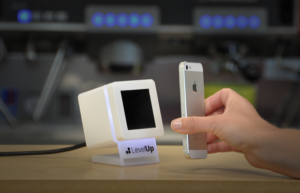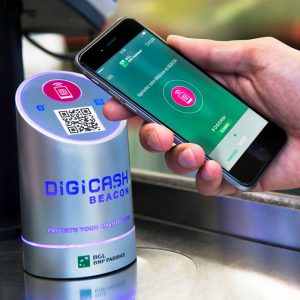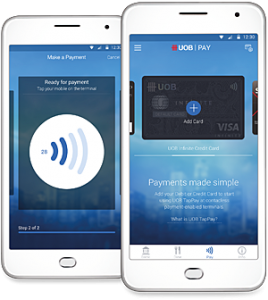 Mobile Payments using NFC & BLE Beacons lead the way for new marketing technologies.
Mobile Payments using NFC & BLE Beacons lead the way for new marketing technologies.
The possibilities of smart devices, mobile payments, wearable technology & NFC are beginning to take a grip in consumer trends and forecasts. The figures can’t be denied. “Payments made through NFC, will witness the highest year-over-year growth rate, increasing at over 59% in 2016,” according to Future Market Insights.
The increase in wearable technology, smart mobile devices and mobile payments opens the way for marketers to be more sophisticated in their approach to consumer marketing.
Location based technology in smart mobile devices and NFC for payments is clearly transforming the relationships between brands and their customers.
Mobile devices like the Apple Watch and other smart mobile devices can interact with Beacons and NFC allowing for the seamless integration between the brand experience, wearable technology and point of sale payments.
 These technologies together allow companies to create new processes that enhance customer experiences. Brands can personalise their services to provide the exact products and services their customers want, in a specific moment or situation. NFC and BLE are only two of the payment solutions bridging the gap between the customer, their device & location, context and faster, seamless payments . In this infographic NFC vs Beacons you can see the differences between these two technologies for proximity marketing and their potential for different uses towards mobile payments.
These technologies together allow companies to create new processes that enhance customer experiences. Brands can personalise their services to provide the exact products and services their customers want, in a specific moment or situation. NFC and BLE are only two of the payment solutions bridging the gap between the customer, their device & location, context and faster, seamless payments . In this infographic NFC vs Beacons you can see the differences between these two technologies for proximity marketing and their potential for different uses towards mobile payments.
The brand benefits of NFC and BLE Beacons
- Seamless payment experiences.
- Increased service levels in places like hotels, restaurants, museums and theme parks.
- Tailored brand experiences based on individuals/groups preferences.
- More opportunities to create a more relevant brand experience.
The financial benefits of NFC and BLE Beacons
- Simply put, if it’s easier to pay, people will pay more, more often.
- Micro payments are more likely, with new processes and ease of payment.
- Increased service staff efficiency, either saving on cost or increasing staff service.
- Customer’s permission to charge can be given upfront leading to increased revenue.
 There is a growing number of headlines about NFC and Location Beacon technology as more payments and offers are made using these technologies. A trend in this area provides new opportunities for brand marketing teams to be creative, engaging customers in the context of their customer journey, increasing service levels and payments. These are some of the headlines from the month of June 2016.
There is a growing number of headlines about NFC and Location Beacon technology as more payments and offers are made using these technologies. A trend in this area provides new opportunities for brand marketing teams to be creative, engaging customers in the context of their customer journey, increasing service levels and payments. These are some of the headlines from the month of June 2016.
Brits Foresee Cashless Society By 2036
More than two thirds of UK consumers (68%) believe that cashless technologies will completely replace physical money by 2036, research released by the Mayor of London’s promotional company London & Partners reveals.
The figure is higher in London, where three quarters of people believe cash will disappear within 20 years. The research is based on 2,000 respondents and has been released to coincide with London Technology Week, hosted by London & Partners and MasterCard.
Mobile payments to grow 42% in 2016
Mobile payment transaction volume will grow by 42% to reach 26.9m in 2016, up from 18.9m in 2015, research from Future Market Insights predicts. “In terms of value, this will represent nearly US$768.78bn, up from $549.91bn in 2015,” the firm says. “Payments made through NFC, widely touted as the technology of the future, will witness the highest year-over-year growth rate, increasing at over 59% in 2016.”
Strong uptake of Apple Pay in Singapore
 Singapore bank UOB expects that NFC mobile payments will account for 10% of all its card transactions by 2020 on the back of “swift adoption of Apple Pay”, according to The Business Times. Around 19,000 cards from UOB have been enabled for Apple Pay in just two weeks since the bank announced its support for the service in May 2016.
Singapore bank UOB expects that NFC mobile payments will account for 10% of all its card transactions by 2020 on the back of “swift adoption of Apple Pay”, according to The Business Times. Around 19,000 cards from UOB have been enabled for Apple Pay in just two weeks since the bank announced its support for the service in May 2016.
BLE beacons to deliver 1.6bn coupons a year by 2020
Almost 1.6bn coupons will be delivered annually to consumers via Bluetooth Low Energy (BLE) beacon technology by 2020, Juniper Research forecasts. “This is up from just 11m this year, as retailers seek to develop proximity marketing campaigns in and around their stores,” the firm says. “Spend on digital retail marketing is set to increase from US$174bn in 2015, to $362.1bn by 2020.”
This is a growth area and the tech companies providing these technologies will no doubt grow as we move towards a cashless society. The bigger opportunity right now is for companies to implement new process in the context of their consumers, their location, mobile devices and the services that can be made available to them in the context of their brand experience.
Source: Business 2 Community

You must be logged in to post a comment Login